Here’s an age-old question we receive from readers – can a cruise ship tip over? While technically possible, it is not as probable as you’d think.
The cruise industry hosts over 20 million passengers annually on hundreds of cruise ships. However, some non-cruisers seem fixated on the unlikely possibility of a cruise ship capsizing.
Despite their ever-increasing size, the design of today’s cruise ships, and advanced technology, there’s no need to spend your cruise worrying about your ship tipping over.
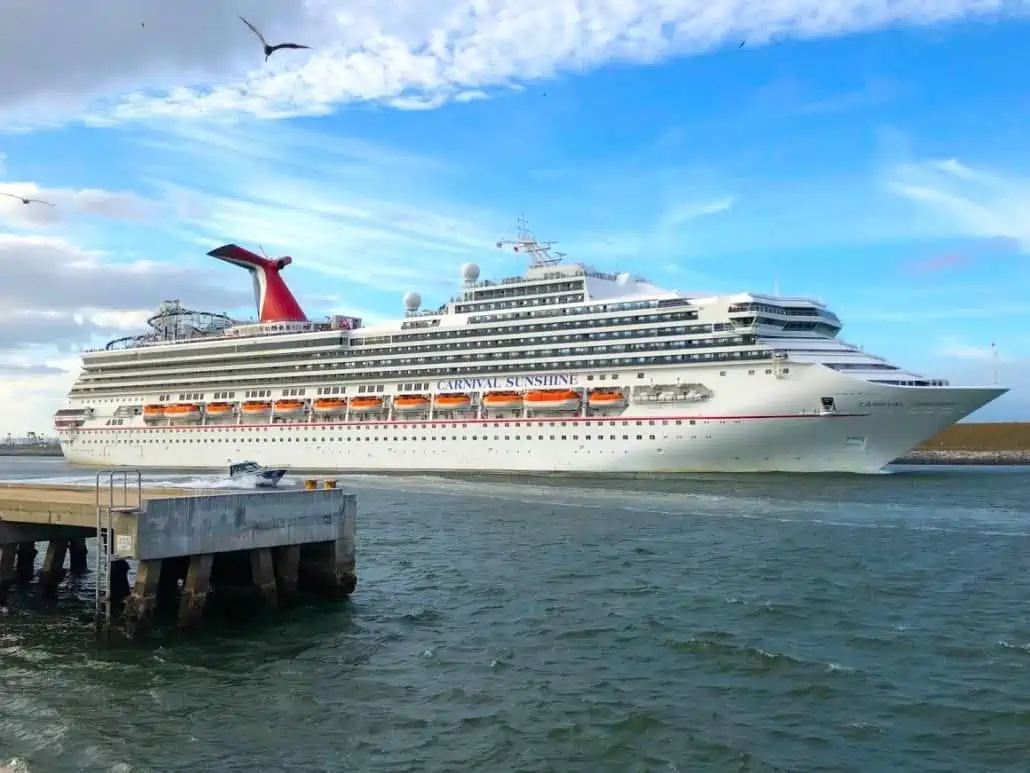
Carnival Sunshine leaving Port Canaveral. (Photo via Doug Parker/Cruise Radio)
Understanding the design of a cruise ship will help calm any nerves you may have as a cruiser. The cruise industry is a business, including providing a safe and smooth journey.
That said, cruise ships are built to withstand rough seas and large waves, and they have a balance between buoyancy and weight.
The top part of the ship floats and maintains buoyancy, with the bottom part weighing it down. This balance is managed in the middle part of the ship to maintain its centering.
Understanding Cruise Ship Design

(Image via Shutterstock)
Ships are not only larger than ever but also incredibly safe. Have you ever wondered how one of the world’s largest cruise ships, the 236,800-ton Wonder of the Seas, doesn’t tip over?
In this case, Royal Caribbean, like other cruise lines, hires teams of naval engineers and architects who run hundreds of buoyancy tests to ensure crew and guest safety.
And with today’s computer modeling, cruise ship safety is light years ahead of just a few decades ago.

Icon of the Seas during sea trials. (Photo via Doug Parker/Cruise Radio)
During sea trials – which occur well before a ship carries its first passenger – the vessels are put through almost every conceivable scenario concerning stability.
In 2009, the navigational team on Carnival Dream heeled (laid the ship over) the ship 45 degrees. Royal Caribbean did the same thing with Oasis of the Seas. It heeled 30 degrees intentionally during trials.
Marine tests show cruise ships can roll to nearly 60 degrees before they likely hit a point where they won’t return upright. However, you would not want to be on a ship with more than 15 degrees.
Stability Features
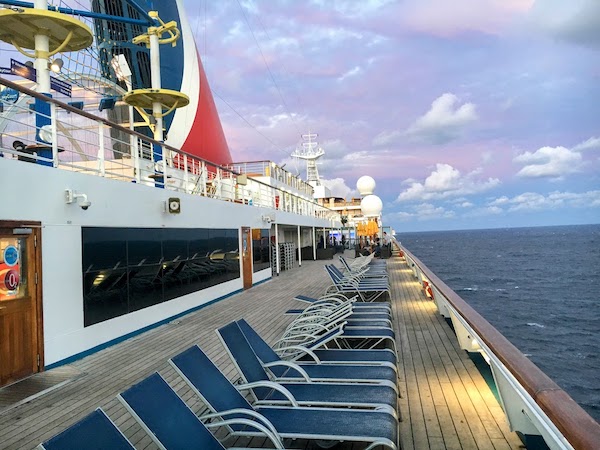
Carnival Conquest at sea. (Photo via Doug Parker/Cruise Radio)
One of the most important features is the ship’s center of gravity. The center of gravity is where the ship’s weight is evenly distributed.
The ship’s center of gravity must be carefully calculated and positioned to ensure that the ship remains stable in all conditions.
Another important stability feature is the ship’s ballast, composed of a heavy material, such as water or sand, used to help stabilize the ship.
Ballast is located at the bottom of the ship and can be transferred from side to side to help maintain the ship’s balance. Cruise lines can use seawater or fuel for stability during sailing.
When calculating a ship’s center of gravity, the weight of fuel and water that is several tons is also taken into consideration for ballast.
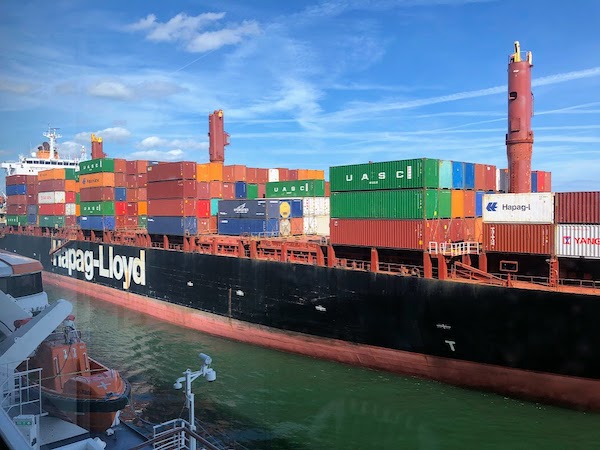
A container ship entering PortMiami early in the morning. (Photo via Doug Parker/Cruise Radio)
Cruise ships also have stabilizing fins extending from the ship’s side, which help reduce the ship’s rolling motion, especially in rough seas, creating a more enjoyable experience for guests.
Stabilizers can be retractable and adjusted based on the ship’s speed and sea conditions.
However, there comes a point when even the stabilizers can’t maintain smooth sailing.
Weight Distribution
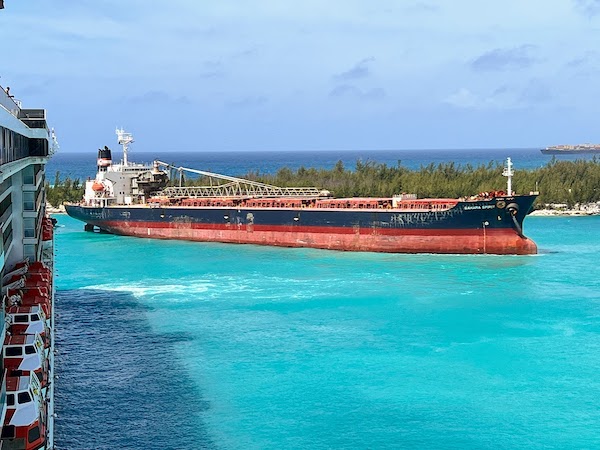
A cargo ship entering Freeport, Bahamas. (Photo via Doug Parker/Cruise Radio)
Weight distribution on a cruise ship is critical to maintaining stability as it must be evenly distributed from side to side and front to back.
Imagine if, at any moment, all of the ship’s bars, lounges, and other facilities were on one side of the ship; this would cause a weight imbalance.
Cruise ship stability is achieved by evenly distributing public spaces and machinery, such as engines, fuel tanks, fresh and wastewater, and cargo throughout the ship.
Cruise ships are designed with multiple decks and heavier components on the lower decks.
This helps to lower the ship’s center of gravity, making it more stable. The ship’s fuel tanks are also located at the bottom, which helps keep the ship’s weight low.

(Photo via Doug Parker/Cruise Radio)
In addition to careful weight distribution, many cruise ships have double-hull construction that provides additional protection if the hull becomes compromised.
If the outside hull is damaged, the secondary hull maintains a watertight seal to keep the boat upright and reduce flooding.
A feature that your average cruiser might not know about, but it can be comforting to someone who may be afraid to try out a cruise for the first time.
If you’re interested in the details, a study conducted at the Fisheries and Marine Institute of Memorial University of Newfoundland outlines the history and calculations involved in determining buoyancy.
Factors That Could Cause a Cruise Ship to Tip Over
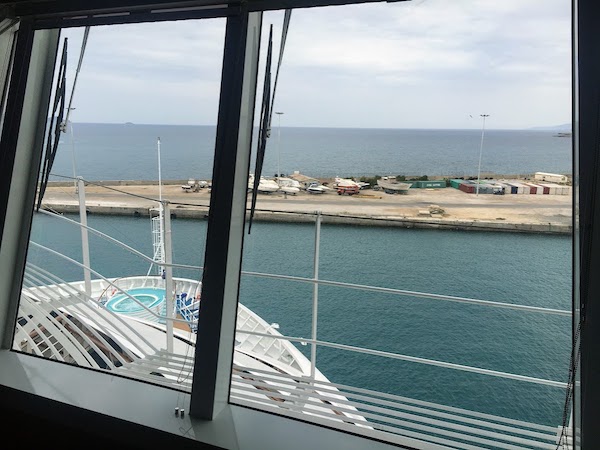
(Photo via Doug Parker/Cruise Radio)
Ultimately it would take an extreme act or carelessness to flip a ship over. In the cruise line’s best interest, its ships are designed to be stable and safe.
However, in the rare case that a cruise ship might tip over, here are a few possibilities for why that may occur.
Human Error
This was best documented in 2006 when Crown Princess left Port Canaveral and unexpectedly listed up to 45 degrees.
An investigation by the National Transportation Safety Board (NTSB) eventually concluded that the likely cause of the Crown Princess accident was the second officer’s erroneous steering wheel commands.
These were initially made to correct an unexpectedly high turn rate and address the ship’s tilting.
Contributing factors included the captain and staff captain’s improper inputs into the integrated navigation system, while in high-speed, shallow waters, they failed to stabilize the ship.
As a cruise ship moves through shallow water, it creates a low-pressure area underneath its hull. This low-pressure area can cause the ship to sink slightly, which can increase its draft and make it more difficult to control.
Severe Weather Conditions
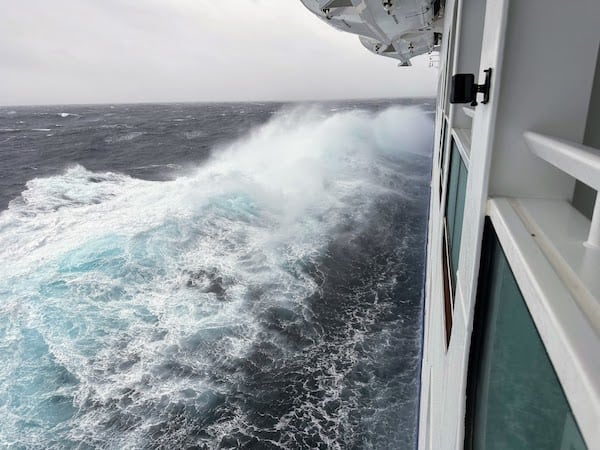
Rough seas in the North Atlantic. (Photo via Doug Parker/Cruise Radio)
Inclement weather can significantly affect a ship’s stability, as high winds, large waves, and heavy rain can all contribute to a vessel’s pitching and rolling.
RELATED: Should Cruisers Be Able to Sue in Rough Weather?
When a ship encounters severe weather conditions, the crew will typically take steps to minimize the ship’s exposure to the weather, including changing course, slowing down, or even stopping the ship altogether. The cruise ship’s captain, navigation team, and engine team are highly trained, and safety is always their priority.
Mechanical Failure
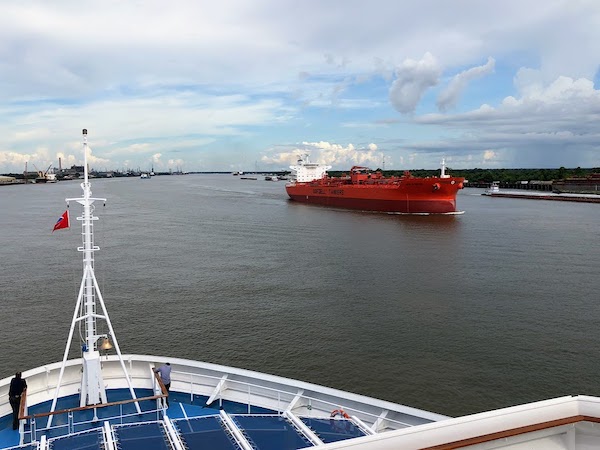
(Photo via Doug Parker/Cruise Radio)
Mechanical failure is another factor that could cause a cruise ship to tip over. There are many mechanical systems on a cruise ship; if any of these systems fail, it could compromise its stability.
For example, if a ship’s ballast tanks fail to operate correctly, the ship could become unbalanced and tip over. Similarly, if a ship’s propulsion system fails, the vessel could be pushed off course and into dangerous waters. Again, this is extremely rare.
RELATED: Are Cruise Ships Safe?
Cruise ships undergo rigorous inspections and maintenance procedures to prevent mechanical failure,
In the event of a mechanical failure, crew members have a plan in place, and many times, as a cruiser, you may never know there was a problem.
Most cruises sail without incident but know there’s always a backup plan.
Can a cruise ship tip over: The safety measures in place
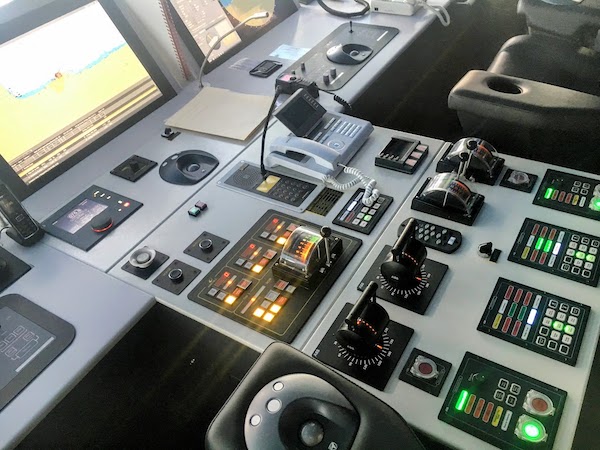
The navigational bridge on a cruise ship has multiple warning systems. (Photo via Doug Parker/Cruise Radio)
Cruise ships are designed with safety in mind, and many measures are in place to prevent tipping. Here are just a few of the safety measures that are used:
dvanced Warning Systems
Modern cruise ships are equipped with advanced warning systems that can detect changes in the ship’s stability. These systems use sensors to monitor the ship’s movement and can detect if the ship is starting to lift or tilt.
If the system detects any changes in the ship’s stability, an alarm will sound, and the crew will be alerted. This allows the crew to take action quickly, right the ship, and prevent further tipping.
Cruise Ships That Have Tipped Over
Over the years, a few cruise ships have tipped over. But remember, thousands of cruise ships continue to sail daily without incident successfully. Here are some notable examples:
1. MS Estonia
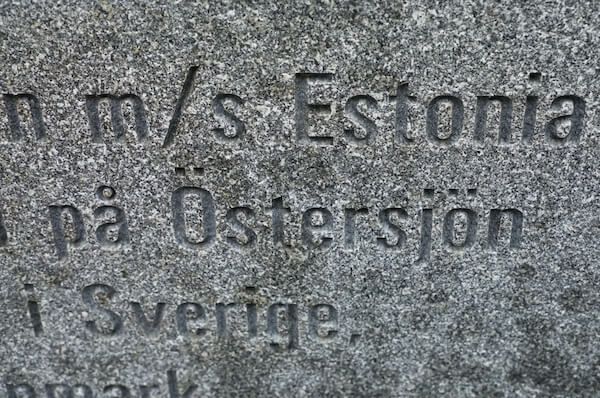
(Photo via Jeppe Gustafsson/Shutterstock.com)
The MS Estonia was a passenger and car ferry that capsized and sank in the Baltic Sea on September 28, 1994. The ship was on its way from Tallinn, Estonia, to Stockholm, Sweden, when it encountered rough seas and high winds. The ship’s forward ramp went into the water, allowing water to flood the car deck and causing the vessel to capsize. Of the 989 passengers on board, only 137 survived.
2. Costa Concordia
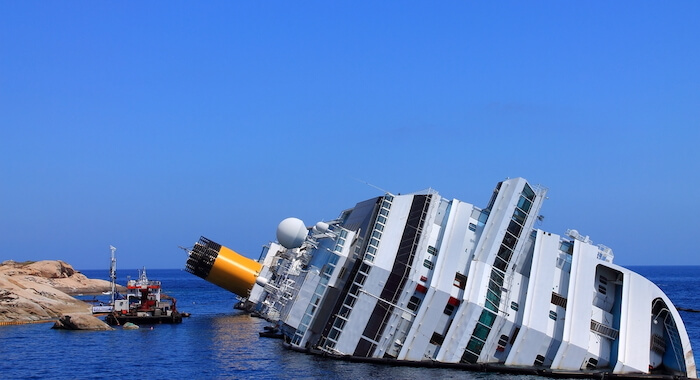
Costa Concordia (Photo via Shutterstock.com)
The Costa Concordia was a cruise ship that sailed for Costa Cruises. It ran aground and capsized off the coast of Italy on January 13, 2012. The ship hit a rock due to negligence of the captain and took on water, causing it to list to one side and eventually capsize. Of the 4,252 passengers and crew on board, 32 died.
Following the incident, the cruise industry undertook an extensive review and, as a result, implemented an array of changes to improve safety. Eventually leading to the development of the Cruise Passenger Bill of Rights.
Other Notable Accidents
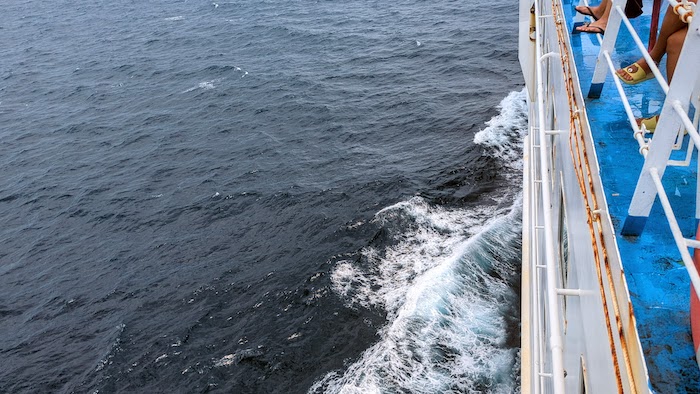
A choppy day taking a ferry in Asia. (Photo via Doug Parker/Cruise Radio)
Another accident included the MS Achille Lauro cruise ship, which caught fire and sank in the Indian Ocean on November 30, 1994. The vessel had a history of mechanical problems and had experienced several previous fires.
The MV Explorer was a cruise ship that sank in the Antarctic Ocean on November 23, 2007. The ship hit an iceberg and began taking on water, causing it to fall to one side and eventually sink. All 154 passengers and crew were rescued by nearby ships.
The mentioned incidents have emphasized the significance of implementing safety regulations and procedures in the cruise industry.
Final Thoughts
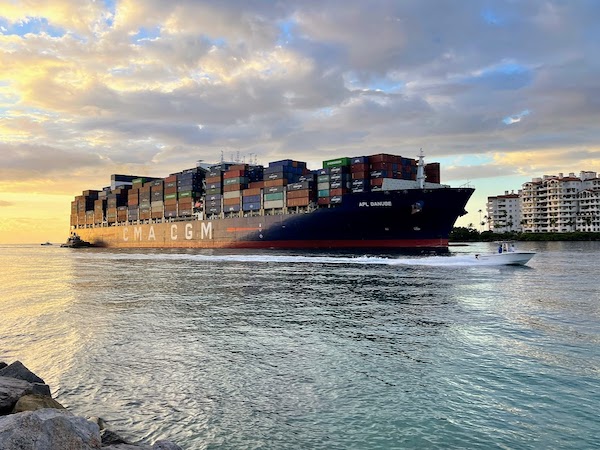
A container ship entering PortMiami early in the morning. (Photo via Doug Parker/Cruise Radio)
A cruise ship list is a highly unlikely event and happens very rarely. Today’s massive cruise ships are more equipped to withstand rough seas and high waves and have extensive safety measures and emergency systems to alert staff of potential issues. Crew members also train regularly on what to do in emergencies, including a ship listing.
Although cruise ships are designed to endure harsh weather conditions and maintain stability, accidents can still occur.
Cruise lines prioritize safety by taking all necessary precautions to prevent accidents and guarantee the safety of their passengers and crew.
An unsafe cruise ship would significantly harm the cruise industry’s business, so they prioritize ensuring a secure and safe operation.
RELATED: Why Are Cruises to Nowhere Illegal in the United States?
Frequently Asked Questions
Can a cruise ship survive a rogue wave?
Modern-day cruise ships are designed to withstand rough weather conditions, including rogue waves, which happen from time to time. Cruise ships are built with stabilizing systems that help to keep them upright during storms.
Has a cruise ship ever tipped over?
Cruise ships can and have tipped over, but it is extremely rare. One of the most notable incidents was the capsizing of the Costa Concordia in 2012, which resulted in the deaths of 32 people. The accident was attributed to human error and resulted in many changes within the industry, particularly in bridge management.
How many cruise ships have tipped over?
While there have been instances where a cruise ship has tipped over, these incidents are extremely rare. According to the Cruise Lines International Association, there have been only a handful of incidents where a cruise ship has capsized in the past 20 years. During this time, the cruise industry has carried tens of millions of passengers safely.
How does a cruise ship not tip over?
Cruise ships have several features that help keep them upright during storms, including stabilizing systems, ballast tanks, and a low center of gravity. Marine engineers run extensive modeling to test a ship’s stability in all conditions.
How does a cruise ship float?
Cruise ships are designed to balance buoyancy and weight to maintain stability. The topmost part of the ship retains its buoyancy while the bottommost piece weighs it down. This balance is managed in the middle part of the ship to keep it centered.
----------------------------
By: Doug Parker
Title: Can a Cruise Ship Tip Over? Exploring the Truths
Sourced From: cruiseradio.net/can-a-cruise-ship-tip-over-facts-and-risks/
Published Date: Wed, 13 Sep 2023 00:29:03 +0000
Read More
 Privacy PolicyTerms And Conditions
Privacy PolicyTerms And Conditions
